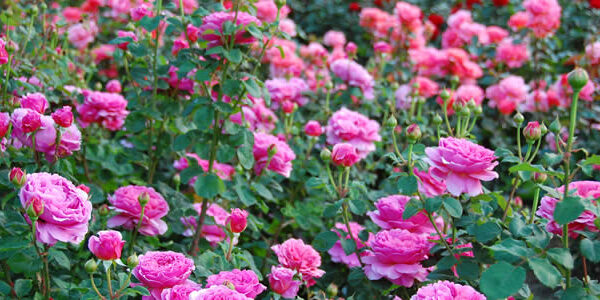
Nothing defines an English garden like a Rose. In surveys, it always top the charts as the most popular plant to grow and they are the largest group of plants available to gardeners.
With such diversity, choosing one can be a daunting prospect. Luckily, I’m on hand to guide you in selecting the right rose for you and how to look after it.
History
In researching this article, I wanted to know why roses meant so much to us. Just why are they topping those surveys?
As a species they are known to have originated in China and then spread over the whole of the northern hemisphere between 60 to 70 million years ago.
In terms of human involvement, the earliest known planting of roses occurred along the well-travelled routes of early nomadic humans, most likely for their food value. As human populations settled, roses were grown in apothecary gardens for their medicinal use.
In 500B.C.E, the renowned Chinese philosopher and politician Confucius wrote extensively about roses, highlighting that the Emperor’s library contained several hundred books on the subject.
During the Han dynasty (207B.C.E. to 220 C.E.), the Chinese were so enthralled by roses that there were problems with rose cultivation encroaching onto land dedicated to agricultural use. This led to an Emperor’s Decree to plough some rose gardens over, returning them back to food production.
Elsewhere in the world, there is evidence to show that the Egyptians, Greeks, Romans and Phoenicians not only appreciated roses but also cultivated them as early as 5000 years ago.
The more you look, the more it can be seen that roses have been an integral element of the human story. It is no surprise then, that the rose holds such a deep connection with us. It’s almost as if our relationship with it is etched in our ancestral memory.
In more modern times, roses have come in and out of fashion. Currently they are back in, due to the great work of specialist growers. One of the most well-known and respected of these is David Austin, who works with old English roses to create new hybrids with showy blooms and magnificent scent.
Types of Roses
Today, roses are separated into wild, old garden and modern varieties. There are eleven distinct groups of wild rose and the varieties we see in garden centres today are hybrids of these.
At Haskins, we’ve simplified things by grouping roses for their specific use:
• Patio – these are smaller, compact varieties that are great for growing in pots. They usually have tight clusters of small flowers and can be either dwarf shrub or smaller climbing roses.
• Shrub – Usually growing between 4 and 6ft (1.2m – 1.8m), shrub roses are a large and diverse group. They can be enjoyed as individual specimens or grown as a hedge. Notable David Austin varieties are:
- Gertrude Jekyll for its heady scent and showy, blackcurrant mousse coloured double flower. The growth is upright and vigorous and it’s very reliable and hardy.
- The Poet’s Wife for its beautiful, double lemon coloured flowers oozing a strong citrus scent. Its growth is low and rounded and it has excellent repeat flowering.
• Climbers – usually grow to about 6ft (1.8m), repeat flower all summer and well into autumn. Notable David Austin varieties are:
- Falstaff for its large crimson blooms offering a strong classic old rose fragrance. It’s also a good short climber for a wall.
- A Shropshire Lad as it excels both in beauty and performance, with its peachy-pink flowers and fruity scent. It’s also very hardy and one of the best English climbing roses.
• Ramblers – generally grow more than 6ft (1.8m) and flower once, normally around June. Recommended David Austin varieties include:
- Paul’s Himalayan Musk. It’s one of the best and most beautiful ramblers with clusters of pretty, blush-pink flowers giving an airy effect. Like most ramblers it only blooms once a year but it does so in such abundance it makes a magnificent display. It also has a wonderful musky fragrance.
- The Albrighton Rambler. Being unusual in that it repeat flowers, this is a short healthy rambler with small, semi-double pink flowers blessed with a light musky scent.
• Groundcover – tend to flower profusely and are branded at Haskins as ‘Flower Carpet Roses’. These roses form a carpet of colour around a meter wide and half a meter high.
Haskins also has an area for Special Occasion roses, which is where you’ll find roses for wedding anniversaries and the like.
Floribunda vs. Hybrid Tea
Within the five main types described above, modern roses can be further subdivided into two main flowering types; Floribunda and Hybrid Tea.
Floribunda roses are a moderately recent invention, arriving on the scene during the 1940s. They usually have small clusters of flowers on a stem to make a colourful display. Nowadays, modern breeding programs are developing the flowers to become bigger and showier.
Hybrid Tea roses have a long stem bearing a single flower, which makes a good cut flower. They are the more popular of the two roses and have been in cultivation since 1867. The name is derived from the two parent roses that created them: repeat flowering Hybrid Perpetual roses and the highly scented Tea roses that originated from China.
General Cultivation
Roses are hungry plants that respond well to generous feeding. They will grow in almost any soil, so long as it is well drained. I always recommend that people add well-rotted compost or manure into the planting area to get their roses off to a flying start. During the winter, these plants also benefit from a mulch of well-rotted manure. I also recommend a plant food specially formulated for roses, such as Top Rose, be applied during the spring and summer.
During the first year after planting they will require a regular watering – especially in prolonged dry spells. Once established, roses can survive on the moisture naturally present in the soil due to their deep root system.
If growing in containers, they will need to be watered so that the compost never dries out or becomes soggy. This could be every day during spells of hot weather.
Pruning
Pruning roses is normally done in late winter (February to March) and the technique is normally tailored to the specific type. However, there are some general rules that can be applied to any rose:
• When cutting a stem, make sure the cuts are no longer than 5mm (1/4inch) above a bud.
• Make your cuts so that they slope away from a bud as it allows water to drain away from the bud, keeping it healthy.
• Always remove any dead, dying or diseased wood by cutting back into healthy parts of the affected stem. This applies to weak, spindly stems and ones that rub against each other.
• When making cuts, try to select an outward facing bud to promote an open centred shape. This creates good airflow to reduce the chance of fungal diseases.
• For ground cover roses, select an inward facing bud to create a more upright habit.
• Trace any suckers back to the roots from which they grow and pull them away.
Additional to the general advice given above, each type of rose has a few specific needs that will help them be at their best:
• For Patio or miniature roses, only perform light pruning, concentrating on removing any twiggy growth. After this, the main stems can be reduced by about a third to a healthy bud. Any vigorous shoots that spoil the overall shape can also be removed entirely.
• Shrub roses generally flower on older wood, so these can be maintained by light but regular pruning, developing a balance of older and younger stems.
• Floribunda roses need their most vigorous stems to be cut back to within 25-30cm (10in-1ft) of soil level and their less vigorous stems cut even more severely.
• Hybrid Tea roses need the strongest shoots shortened to between four and six buds above the point where last year’s wood began. Also, remove all three year old wood, leaving the younger more vigorous shoots which produce better flowers.
• For Climbers, take back any flowered shoots back by two thirds of their length. Cut out any really old branches from the base to promote new growth and tie in any new shoots needed to fill supports.
• For Ramblers, thin and shorten excessive growth by removing one in three of the oldest stems entirely. If space is restricted, prune out all the stems that have flowered and tie new ones in to take their place. Shorten side shoots by about two thirds.
Roses should be dead-headed after flowering, unless the variety produces an attractive hip or seed pod after flowering.
With standard roses – i.e. roses grafted onto a trunk to create a lollipop shape – pruning the crown should be done according to the cultivar used, whether it is a floribunda, hybrid-tea or shrub cultivar.
Fragrance
Roses are often grown for their scent. Whilst red and pink roses hint at a Damask heritage, white and yellows tend to be fruity in nature.
At the heart of the fragrance is a combination of oil and alcohol and its ability to evaporate.
It can be a little disappointing when they don’t smell as the intensity of their fragrance is often determined by climatic conditions.
The ingredients that make up the fragrant formula tend to be rather unstable and require the correct humidity and temperature to evaporate so we can detect them.
If the weather conditions are too windy then evaporation occurs too quickly and the scent blows away. If the weather is too hot and dry then the scent can also evaporate before you’ve had a chance to enjoy it. If the weather is too cold or wet then the fragrance may not express itself at all.
This may seem like a bit of a lottery and I totally understand. My advice is to hedge your bets by growing roses that have been bred to have a strong fragrance – their genetic disposition to create an abundance of fragrance should prevail over climatic conditions to a certain extent.
It is also possible that under feeding as well as over feeding your plants is having a detrimental effect on its fragrant abilities: too little nutrient and the plant cannot create the formula needed for the fragrance and too much nutrient, especially nitrogen, will cause poor flower production. That’s why it’s important to use a balanced fertilizer, such as Top Rose.
Blue roses
Finally, I’d just like to mention the fact that the holy grail of all rose breeders is to come up with a blue rose. This is because European roses tend to be pink, red or white, whilst Middle-Eastern roses tend to be yellow. Blue just doesn’t exist in the rose world.
Scientists and breeders are hard at work trying to create a blue rose but they have yet to make a breakthrough. The closest they have managed to get so far is a colour that I would call lilac. That hasn’t stopped the breeders using the word ‘Blue’ in their labelling though, with names such as Blue for You, Blue Moon and Rhapsody in Blue.
As blue roses do not occur naturally in nature they have become a potent symbol of representing the impossible. Eventually someone is bound to get a breakthrough and when they do they will become very rich and famous. Until then, I kind of like the idea that the blue rose is just out of reach, providing a modern day grail for all those who take up the quest.


